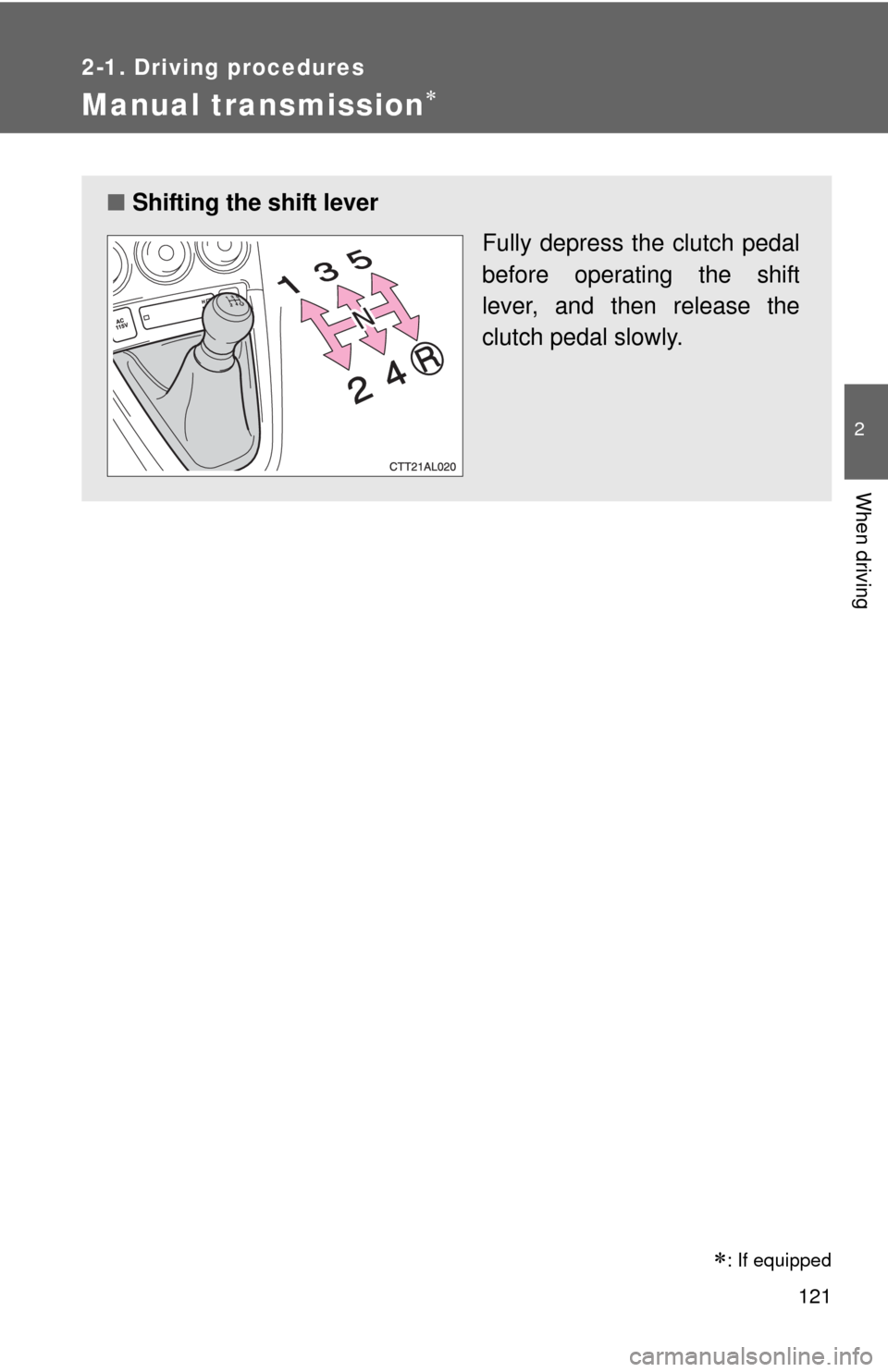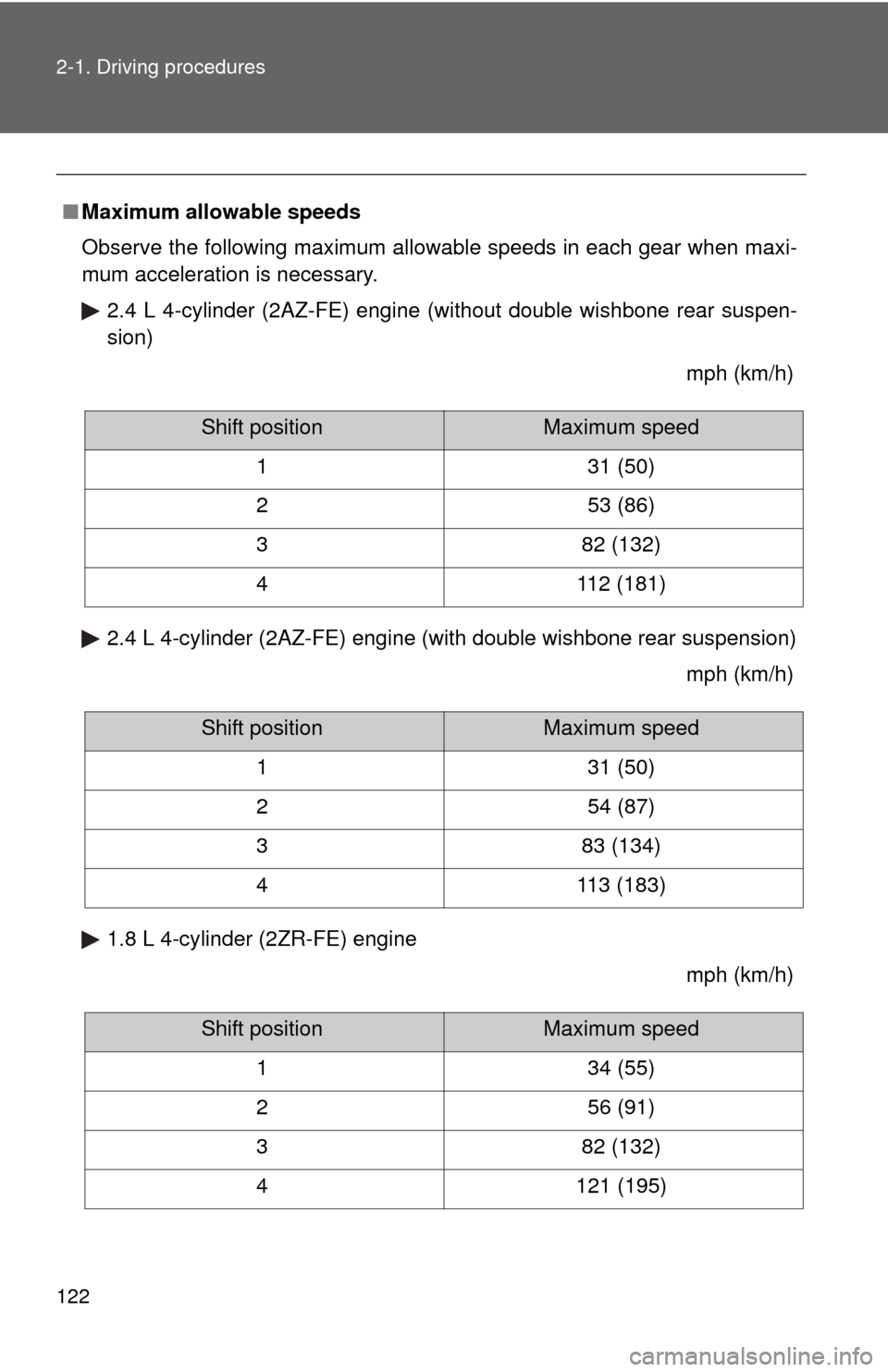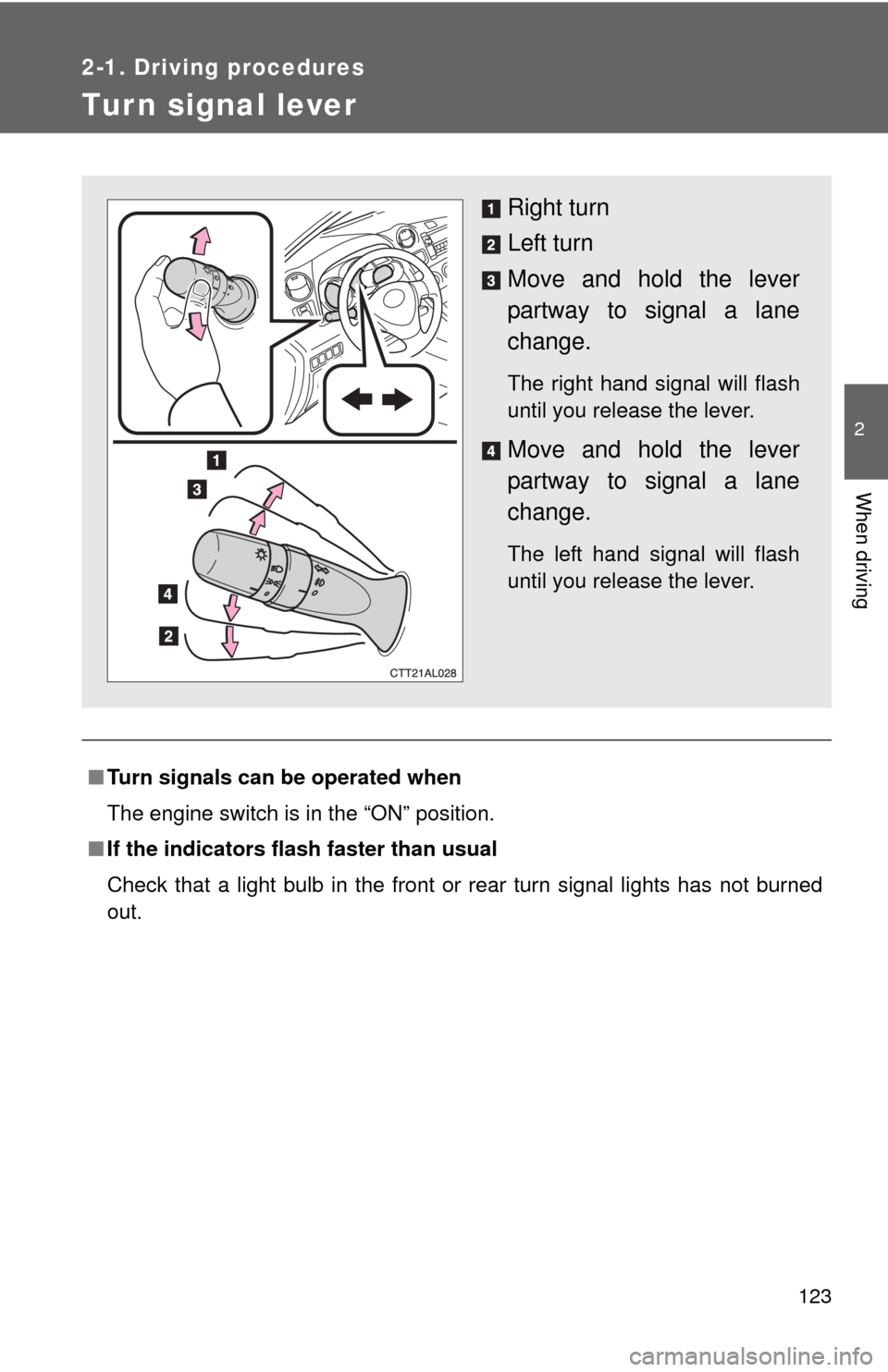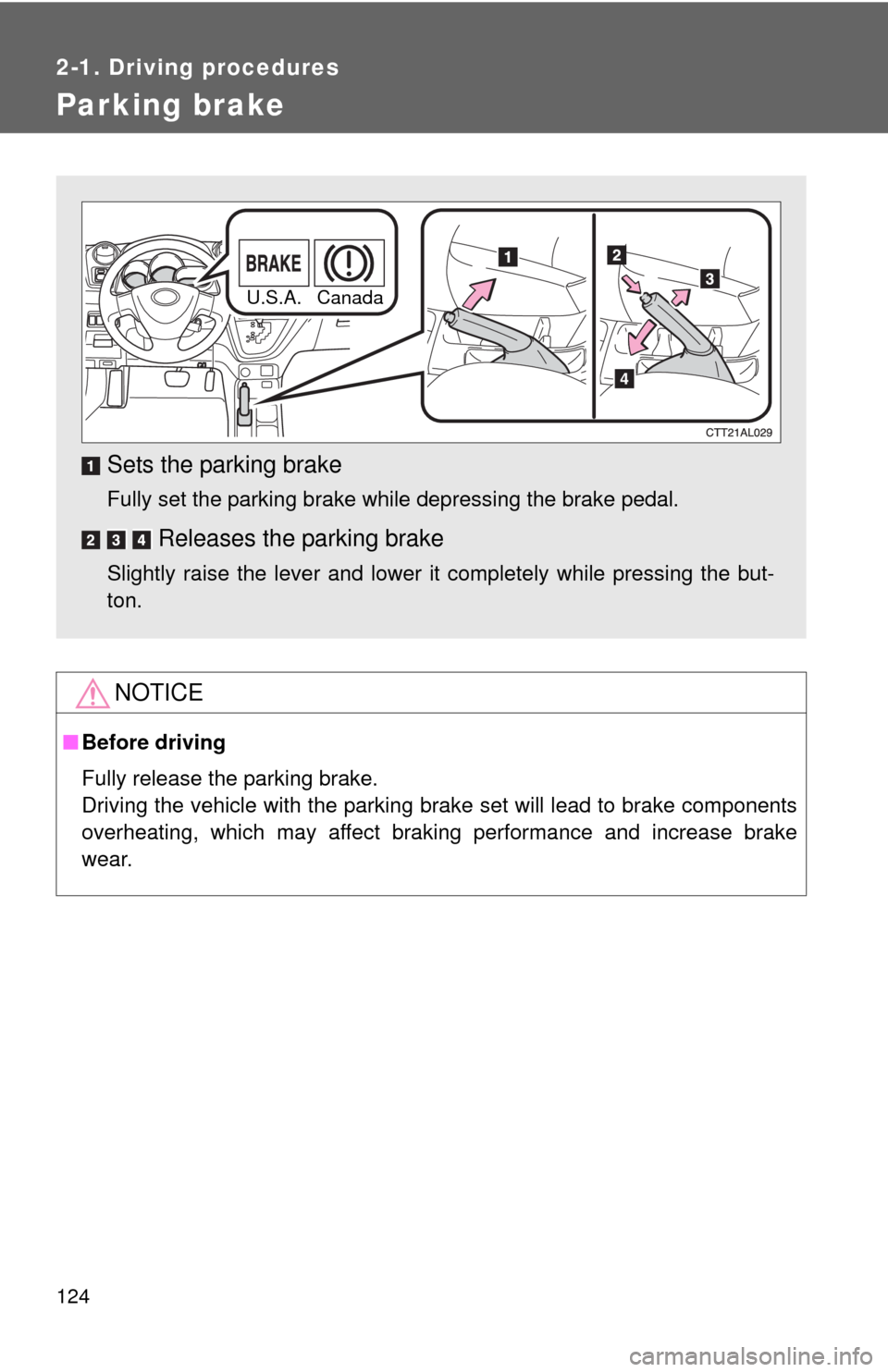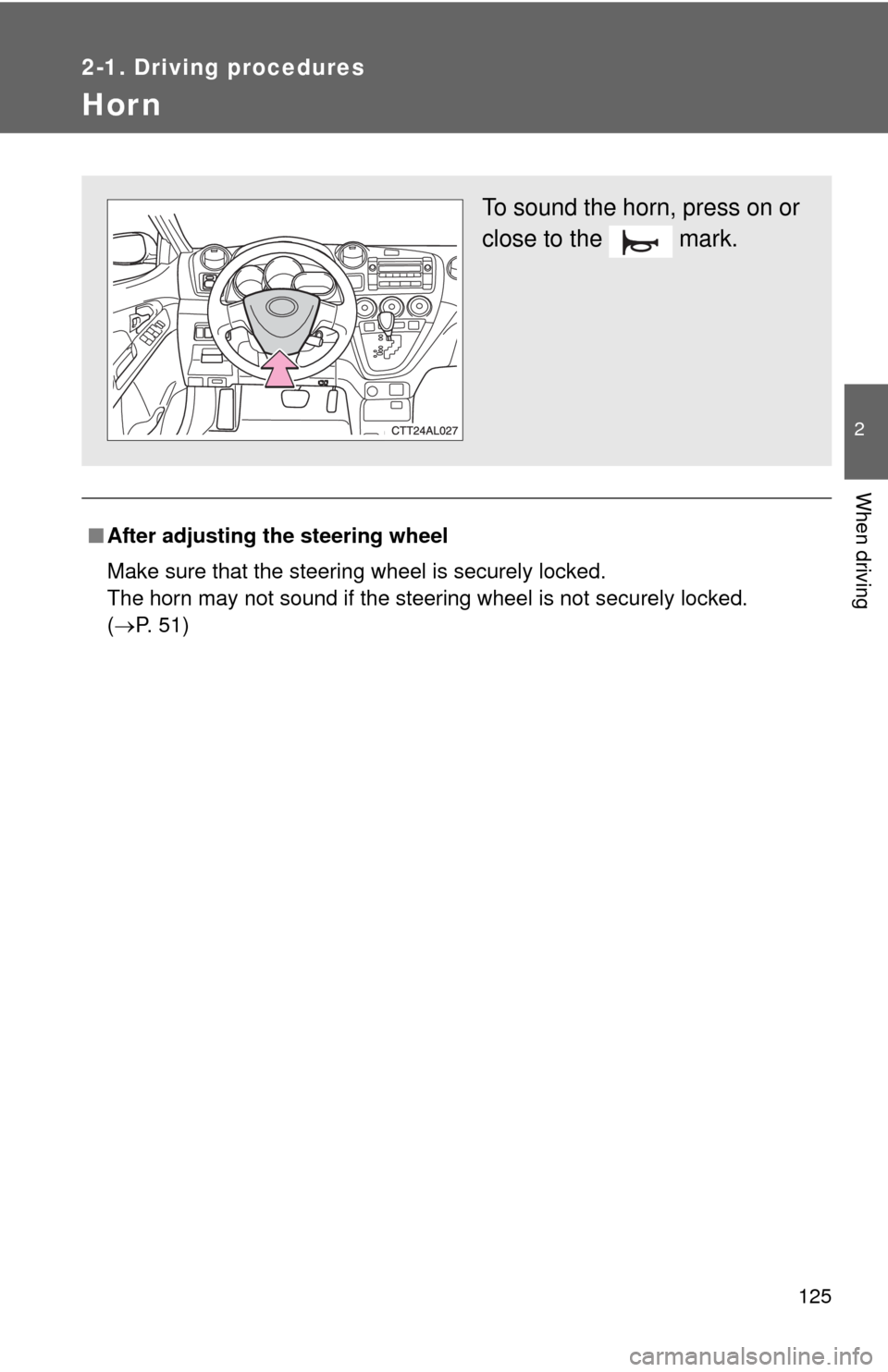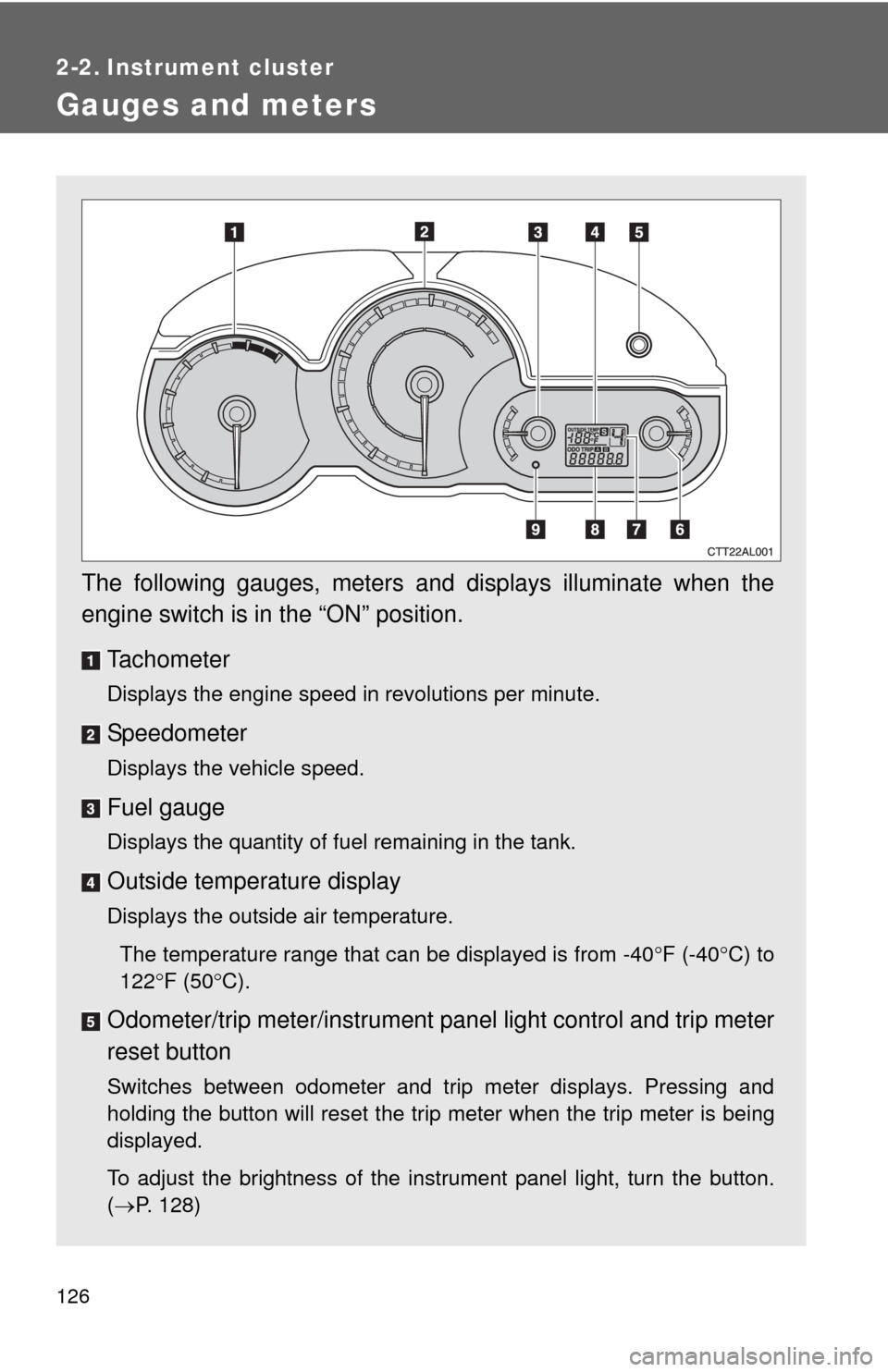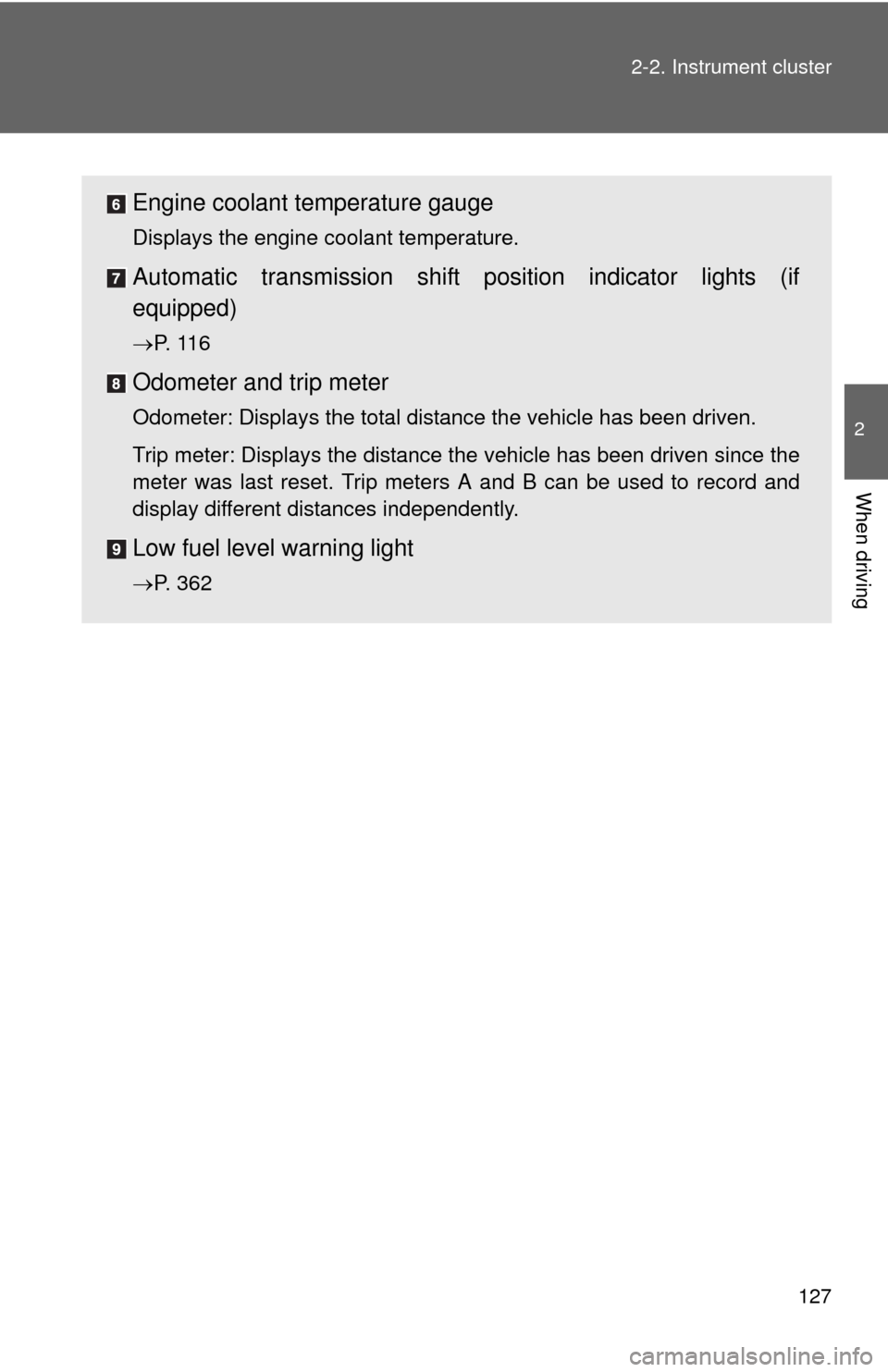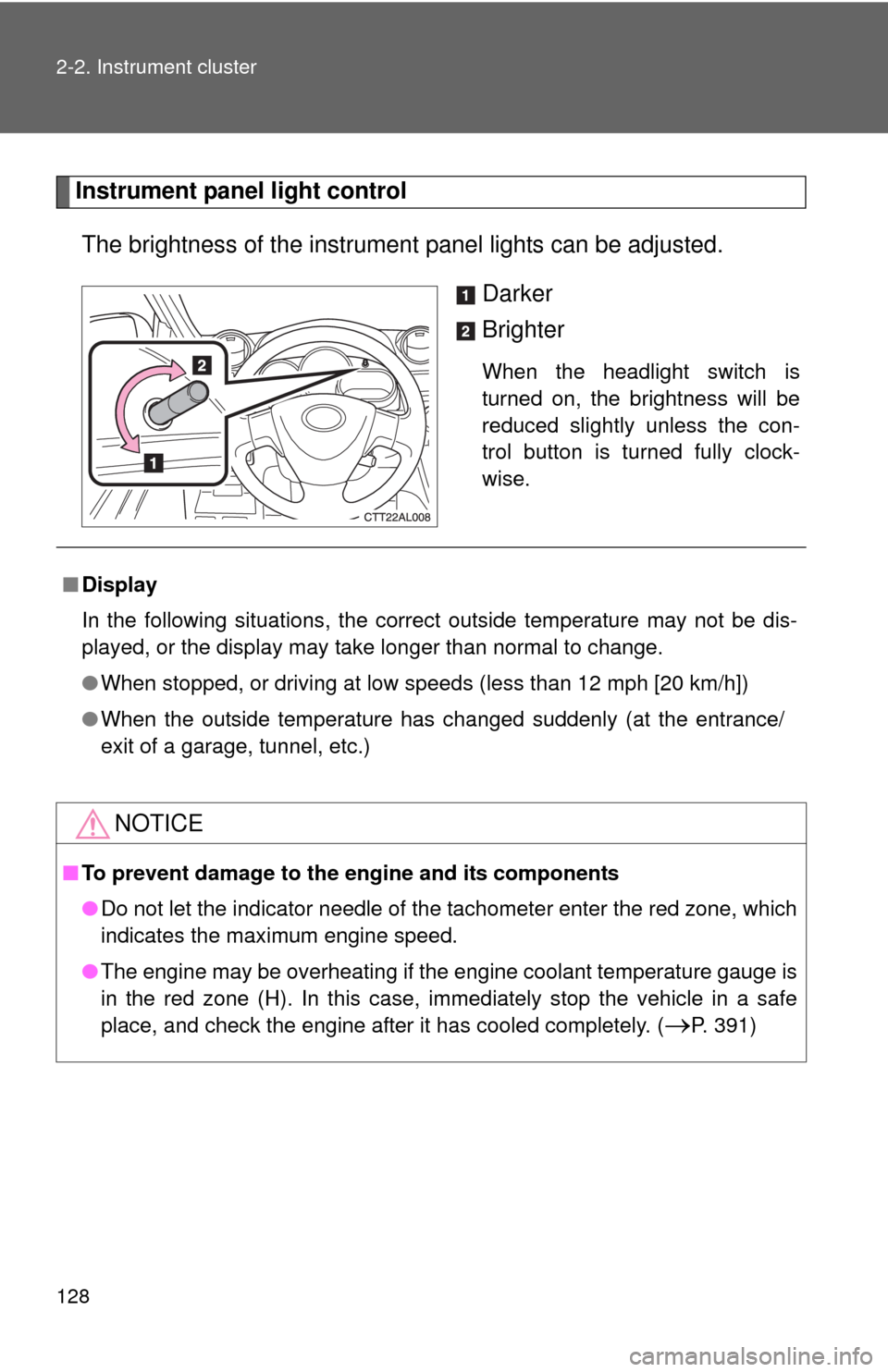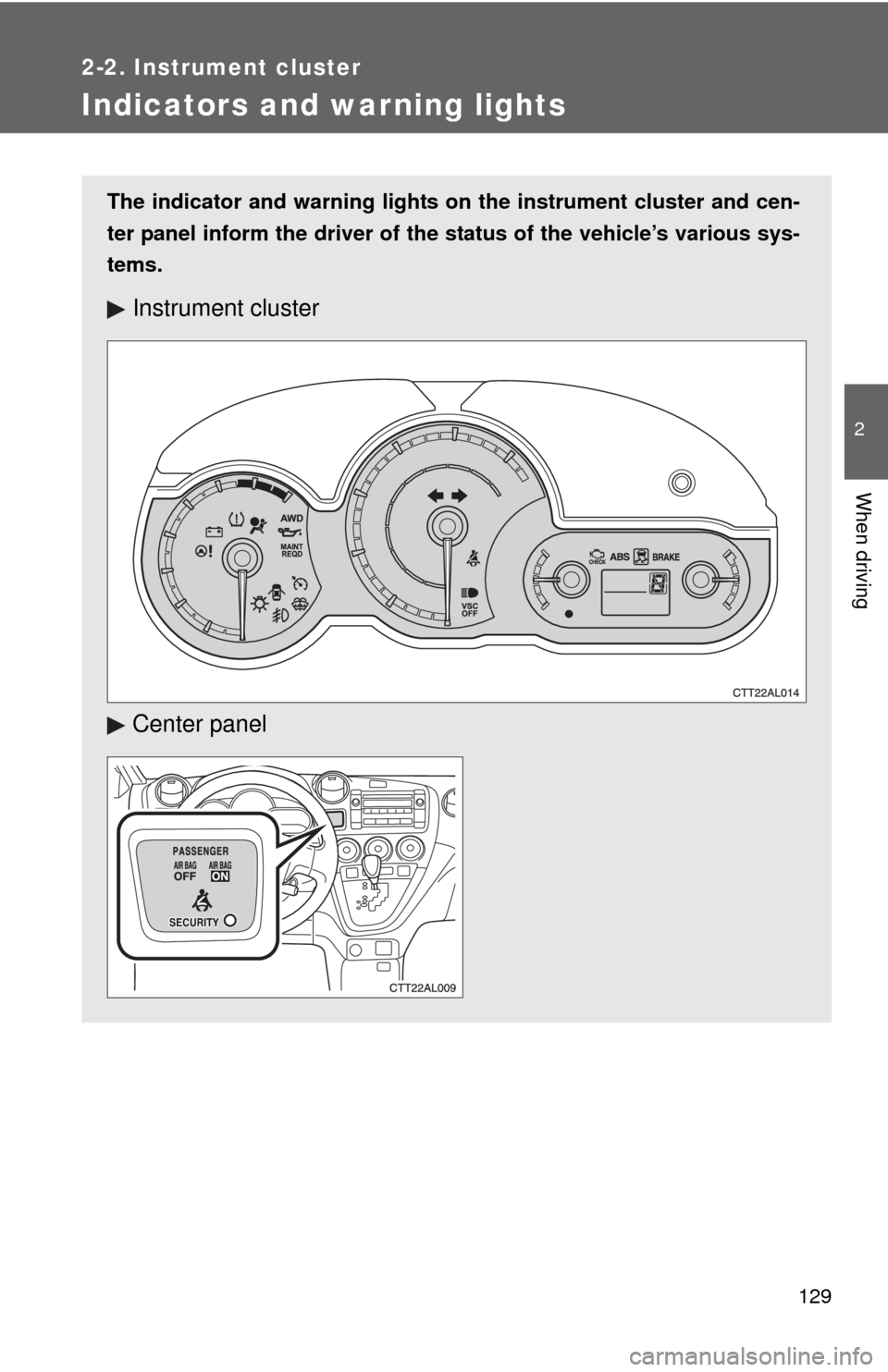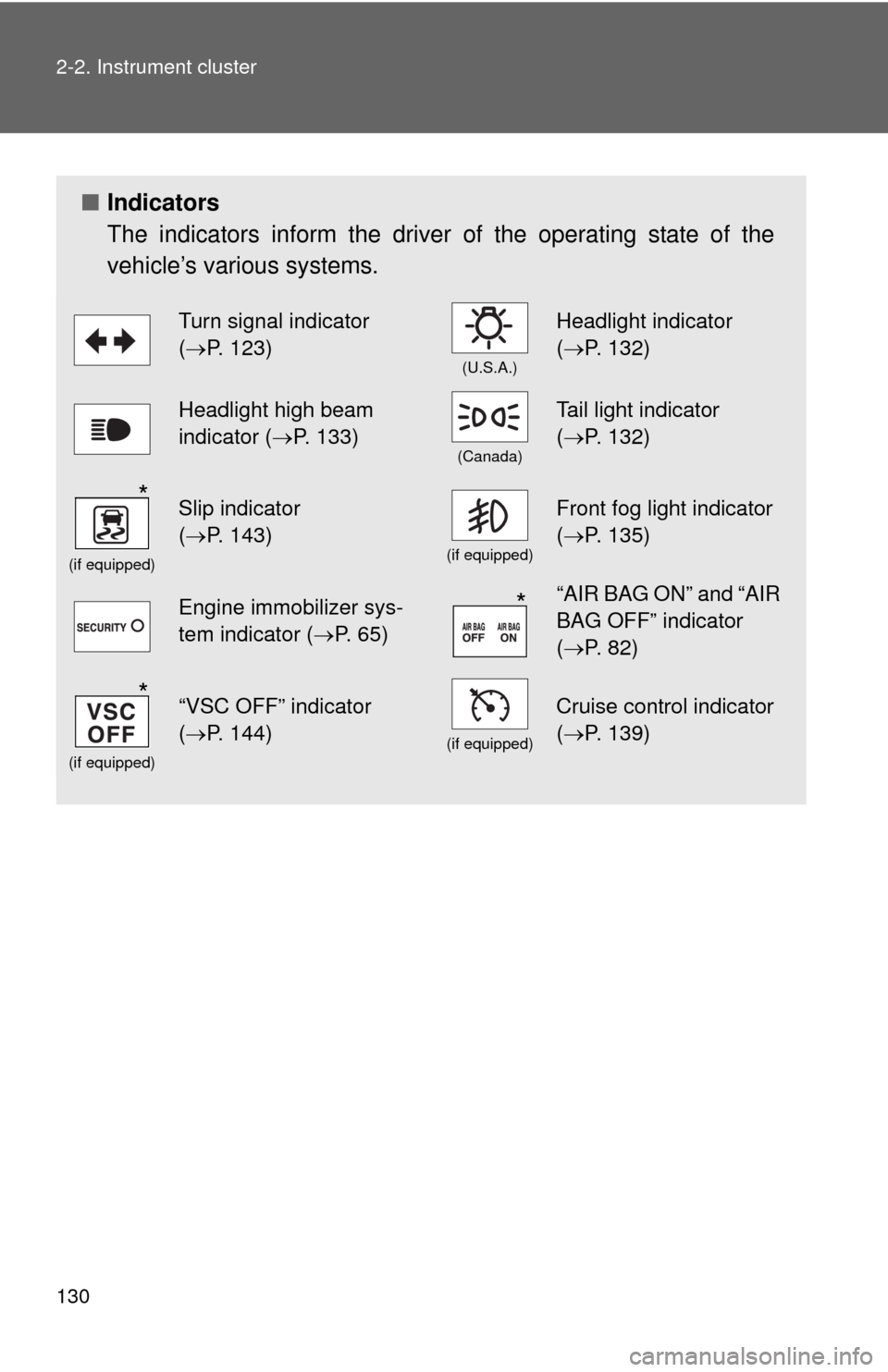TOYOTA MATRIX 2010 E140 / 2.G Owners Manual
MATRIX 2010 E140 / 2.G
TOYOTA
TOYOTA
https://www.carmanualsonline.info/img/14/6535/w960_6535-0.png
TOYOTA MATRIX 2010 E140 / 2.G Owners Manual
Trending: Buzzer, keyless entry, recommended oil, ABS, dimensions, manual transmission, TPMS
Page 121 of 448
121
2-1. Driving procedures
2
When driving
Manual transmission
■Shifting the shift lever
Fully depress the clutch pedal
before operating the shift
lever, and then release the
clutch pedal slowly.
�
: If equipped
Page 122 of 448
122 2-1. Driving procedures
■Maximum allowable speeds
Observe the following maximum allowable speeds in each gear when maxi-
mum acceleration is necessary.
2.4 L 4-cylinder (2AZ-FE) engine (without double wishbone rear suspen-
sion)
mph (km/h)
2.4 L 4-cylinder (2AZ-FE) engine (with double wishbone rear suspension)
mph (km/h)
1.8 L 4-cylinder (2ZR-FE) engine
mph (km/h)
Shift positionMaximum speed
1 31 (50)
2 53 (86)
3 82 (132)
4 112 (181)
Shift positionMaximum speed
1 31 (50)
2 54 (87)
3 83 (134)
4 113 (183)
Shift positionMaximum speed
1 34 (55)
2 56 (91)
3 82 (132)
4 121 (195)
Page 123 of 448
123
2-1. Driving procedures
2
When driving
Tur n signal lever
■Turn signals can be operated when
The engine switch is in the “ON” position.
■If the indicators flash faster than usual
Check that a light bulb in the front or rear turn signal lights has not burned
out.
Right turn
Left turn
Move and hold the lever
partway to signal a lane
change.
The right hand signal will flash
until you release the lever.
Move and hold the lever
partway to signal a lane
change.
The left hand signal will flash
until you release the lever.
Page 124 of 448
124
2-1. Driving procedures
Parking brake
NOTICE
■Before driving
Fully release the parking brake.
Driving the vehicle with the parking brake set will lead to brake components
overheating, which may affect braking performance and increase brake
wear.
Sets the parking brake
Fully set the parking brake while depressing the brake pedal.
Releases the parking brake
Slightly raise the lever and lower it completely while pressing the but-
ton.
U.S.A. Canada
Page 125 of 448
125
2-1. Driving procedures
2
When driving
Hor n
■After adjusting the steering wheel
Make sure that the steering wheel is securely locked.
The horn may not sound if the steering wheel is not securely locked.
(P. 51)
To sound the horn, press on or
close to the mark.
Page 126 of 448
126
2-2. Instrument cluster
Gauges and meters
The following gauges, meters and displays illuminate when the
engine switch is in the “ON” position.
Tachometer
Displays the engine speed in revolutions per minute.
Speedometer
Displays the vehicle speed.
Fuel gauge
Displays the quantity of fuel remaining in the tank.
Outside temperature display
Displays the outside air temperature.
The temperature range that can be displayed is from -40F (-40C) to
122F (50C).
Odometer/trip meter/instrument panel light control and trip meter
reset button
Switches between odometer and trip meter displays. Pressing and
holding the button will reset the trip meter when the trip meter is being
displayed.
To adjust the brightness of the instrument panel light, turn the button.
(P. 128)
Page 127 of 448
127 2-2. Instrument cluster
2
When driving
Engine coolant temperature gauge
Displays the engine coolant temperature.
Automatic transmission shift position indicator lights (if
equipped)
P. 1 1 6
Odometer and trip meter
Odometer: Displays the total distance the vehicle has been driven.
Trip meter: Displays the distance the vehicle has been driven since the
meter was last reset. Trip meters A and B can be used to record and
display different distances independently.
Low fuel level warning light
P. 362
Page 128 of 448
128 2-2. Instrument cluster
Instrument panel light control
The brightness of the instrument panel lights can be adjusted.
Darker
Brighter
When the headlight switch is
turned on, the brightness will be
reduced slightly unless the con-
trol button is turned fully clock-
wise.
■Display
In the following situations, the correct outside temperature may not be dis-
played, or the display may take longer than normal to change.
●When stopped, or driving at low speeds (less than 12 mph [20 km/h])
●When the outside temperature has changed suddenly (at the entrance/
exit of a garage, tunnel, etc.)
NOTICE
■To prevent damage to the engine and its components
●Do not let the indicator needle of the tachometer enter the red zone, which
indicates the maximum engine speed.
●The engine may be overheating if the engine coolant temperature gauge is
in the red zone (H). In this case, immediately stop the vehicle in a safe
place, and check the engine after it has cooled completely. (
P. 391)
Page 129 of 448
129
2-2. Instrument cluster
2
When driving
Indicators and warning lights
The indicator and warning lights on the instrument cluster and cen-
ter panel inform the driver of the status of the vehicle’s various sys-
tems.
Instrument cluster
Center panel
Page 130 of 448
130 2-2. Instrument cluster
■Indicators
The indicators inform the driver of the operating state of the
vehicle’s various systems.
Turn signal indicator
(P. 123)
(U.S.A.)
Headlight indicator
(P. 132)
Headlight high beam
indicator (P. 133)
(Canada)
Tail light indicator
(P. 132)
(if equipped)
Slip indicator
(P. 143)
(if equipped)
Front fog light indicator
(P. 135)
Engine immobilizer sys-
tem indicator (P. 65)“AIR BAG ON” and “AIR
BAG OFF” indicator
(P. 82)
(if equipped)
“VSC OFF” indicator
(P. 144)
(if equipped)
Cruise control indicator
(P. 139)
*
*
*
Trending: alarm, snow chains, lock, tire pressure, coolant reservoir, remote control, maintenance reset
